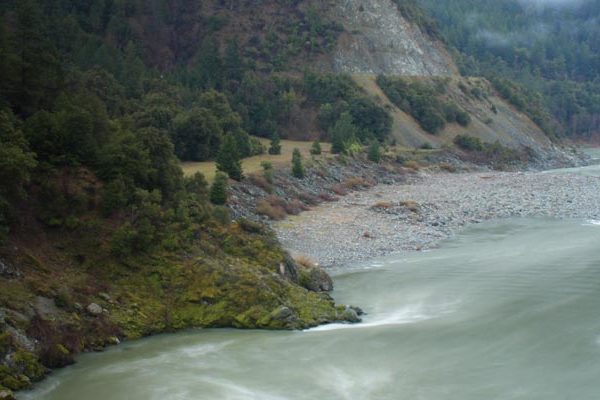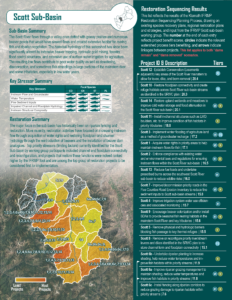Klamath River Basin Integrated Fisheries Restoration and Monitoring Plan

In collaboration with partner organizations, ESSA is developing the Klamath Basin Integrated Fisheries Restoration and Monitoring Plan, which will use the best available science within an Adaptive Management framework to develop basin-scale goals and objectives for the restoration and monitoring of fisheries within the Klamath Basin.
Project Details
Location: |
Klamath River Basin, Oregon/California, USA; N 41°49′32”, W 122°11′53″ | |
Client: |
Pacific States Marine Fisheries Commission & U.S. Fish and Wildlife Service | |
Duration: |
2016 – Ongoing | |
Team Member(s): |
Clint Alexander, David Marmorek, Natascia Tamburello, Marc Porter, Darcy Pickard, Cedar Morton, Caitlin Semmens, Aline Litt | |
Practice Area(s): |
Adaptive Management; Fisheries & Aquatic Sciences | |
Services Employed: |
Facilitation & Stakeholder Engagement, Decision Support & Trade-off Evaluation, Ecosystem Restoration Planning, Science Communication & Knowledge Synthesis, Statistical Design & Analysis, Monitoring Design & Evaluation, Decision-Support Tool Development |
The Problem We Aimed to Solve
The Klamath River Basin of south central Oregon and northern California has historically been among the largest producers of salmon on the Pacific Coast of the contiguous United States. A variety of human pressures have since led to long-term and dramatic declines in Klamath Basin fisheries. These changes have led to substantial hardships for many communities. There has also been decades of conflict and debate over how to restore fisheries of great cultural and economic importance while also sustaining other natural goods and services (e.g., supplying water for farmers, ranchers, local communities and hydroelectric power generation).
How We Helped
Building on strong cooperative foundations laid during previous processes, ESSA is working with Tribal, state and federal government agencies as well as multiple stakeholder groups to produce multiple iterations of a Klamath Basin Fisheries Restoration and Monitoring Plan (IFRMP). This process is using the best available science alongside stakeholder input within an Adaptive Management framework to develop (1) basin-scale goals and objectives to guide planning, (2) potential restoration projects to help meet goals and objectives, (3) a basin-wide monitoring framework to help track the effectiveness of restoration efforts over time. A key underlying principle of the planning process is that native fish species will be able to return to the upper basin either through removal of the four lower Klamath River dams or by adding extensive new and enhanced fish passage infrastructure that allow native fishes to effectively find and migrate past the dams.
Our Project’s Impacts
This complex, multi-year project has unfolded in a series of phases outlined below:
- Phase 1: Stocktaking Through a Klamath Basin Synthesis Report (2016-2017)
During the first phase of this project ESSA produced a Synthesis Report that lays the groundwork for the plan by distilling relevant past and current information about stressors on focal fish populations, habitat conditions and the restoration actions that are being pursued to improve natural ecological processes and bring lasting resilience to the ecosystem. The report provides a representative view of fisheries restoration and monitoring in the basin. Not intended as exhaustive, the document is 523 pages long, a testament to both the complexity and level of effort dedicated to fisheries restoration in this unique system. The Synthesis Report includes input from 30 interviewees, and 54 workshop participants who took part in a 2-day workshop in Yreka, CA. Interviewees and workshop participants represent a cross-section of key experts in specific areas of Klamath Basin management from different Tribes and agencies at multiple levels of governance, as well as NGOs and academia. - Phase 2: First Draft of the Klamath IFRMP – Laying Foundations (2017-2018)
This phase of the project developed a clear vision for restoration in the Klamath Basin, establishing sub-regional working groups of local fisheries and restoration practitioners, developing a suite of conceptual models for each phase of restoration, and establishing a clear objectives hierarchy and core performance indicators (CPIs). This phase of work also sought to make a first attempt at identifying potential restoration actions that had previously been proposed in prior species- or region-specific plans or initiatives, and developed a proposed framework for prioritization of potential actions. Throughout our work, we aimed to integrate innovative concepts and approaches from similar planning efforts developed for other basins such as the Trinity and Elwha.

- Phase 3: Second Draft of the Klamath IFRMP – Refining & Prioritizing Potential Restoration Actions (2019-2020)
With agreement on problem definition and objectives from prior phases, this phase of work further refined a restoration action prioritization framework incorporating a range of both scientific (species ranges, environmental core performance indicators, stressors each action addresses) and stakeholder-driven (scale of benefits, implementability, weight of each criterion) and developed a web-based Klamath Restoration Prioritization Tool to automate the prioritization process. For more information on how to access the tool as a guest, visit: https://kbifrm.psmfc.org/ . This tool was used to engage a diverse set of restoration co-managers, practitioners and interested participants in a series of interactive webinar discussions to help map and refine restoration actions and relative weights reflecting local sub-basin values for use in prioritization (sample outputs shown in summary graphic). - Phase 4: Final Draft of the Klamath IFRMP – Developing Implementation & Monitoring Frameworks (2021 – ongoing)
The next phase of work will focus on laying foundations for the implementation of high-priority projects through (1) further refinement of prioritization inputs and tool (including an interactive GIS mapping module), (2) development of rough cost estimates for proposed restoration actions, and (3) development of a basin-wide monitoring framework to identify assessments and monitoring approaches that may need to be made annually and periodically during each phase of restoration to track progress relative to the Plan’s goals and objectives. This work is expected to begin in early 2021 and carry on into 2022.
For more information on the project’s progress and to access project reports and other outputs, including the web tool, visit: https://kbifrm.psmfc.org/ .

